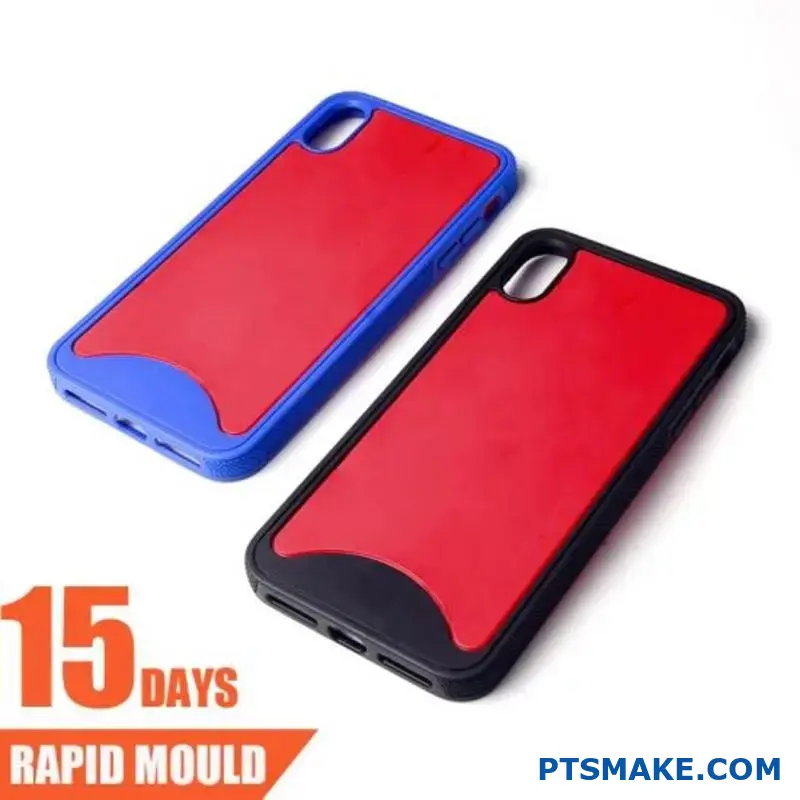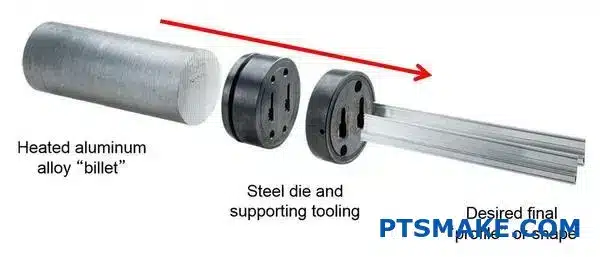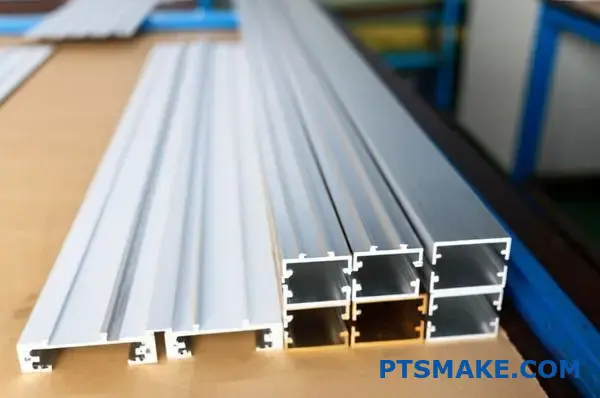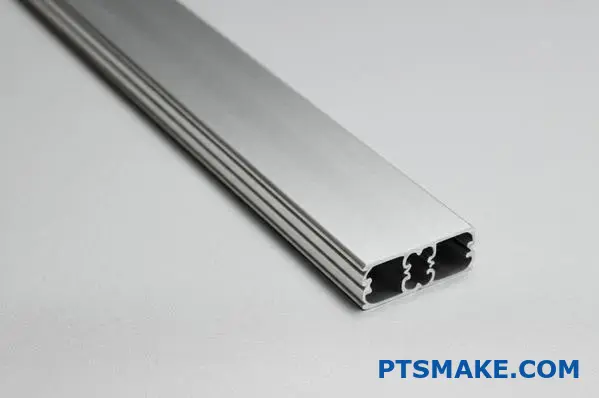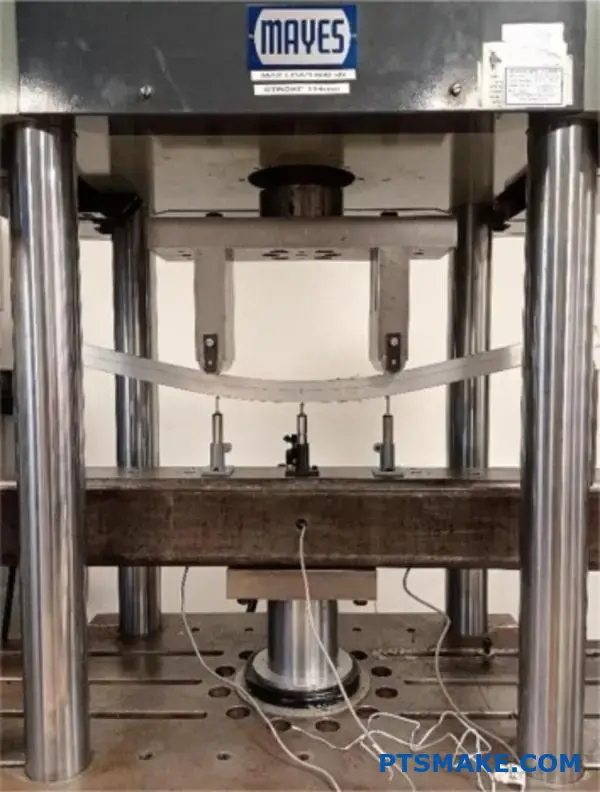Ever tried to find the perfect speaker enclosure material, only to get lost in a sea of options? I know the feeling. With MDF, plywood, aluminum, and plastic all competing for attention, it’s easy to get overwhelmed. Plus, the wrong choice can lead to unwanted resonance, poor sound quality, or speakers that don’t last.
The best material for speaker enclosures depends on your needs, but medium-density fiberboard (MDF) offers the ideal balance of acoustic performance, cost-effectiveness, and workability for most applications. For premium results, Baltic birch plywood and aluminum are excellent alternatives.

I’ve seen how the right enclosure material can transform sound quality. Each material has unique properties that affect acoustics, durability, and manufacturing complexity. Let me walk you through the pros and cons of each option, based on my experience working with manufacturers who produce both consumer-grade and high-end audio equipment. Ready to find your perfect match?
Is Aluminium Enclosure Good for Speakers?
Struggling to pick the right material for your speaker build? Worried that your choice might compromise sound quality or the enclosure’s durability down the line?
Yes, aluminum is an excellent material for speaker enclosures, especially when high fidelity and rigidity are priorities. Its stiffness significantly reduces unwanted cabinet resonance, contributing to clearer, more accurate sound, though it often comes with higher manufacturing complexity and cost.

When exploring materials for speaker enclosures, aluminum often comes up, especially in discussions about premium audio equipment. But what makes it a contender against more traditional materials like wood or MDF? Having worked on numerous projects involving precision components at PTSMAKE, I’ve seen firsthand how material choice impacts the final product, both acoustically and physically. Let’s break down why aluminum is often considered a top-tier choice.
Why Consider Aluminum for Speaker Enclosures?
Aluminum brings several compelling properties to the table for audio applications. Its primary advantage lies in its stiffness-to-weight ratio.
- Rigidity: Aluminum is significantly more rigid than MDF or plywood of the same thickness. This inherent stiffness is crucial for speaker enclosures because it resists flexing and vibrating along with the sound waves produced by the driver. Less cabinet vibration means less unwanted noise or coloration added to the sound, resulting in a cleaner audio output.
- Durability: Aluminum is tough. It resists impacts, scratches, and environmental factors like humidity much better than wood-based materials. This makes an aluminum speaker enclosure a long-lasting investment, especially suitable for portable speakers or equipment used in demanding environments.
- Heat Dissipation: For powered speakers that incorporate amplifiers, heat management is important. Aluminum is an excellent conductor of heat, allowing the enclosure itself to act as a heat sink, potentially improving the longevity and performance of internal electronic components.
- Aesthetics: Let’s be honest, aluminum looks and feels premium. It allows for sleek, modern designs and can be finished in various ways – anodized, brushed, polished, or powder-coated – offering designers significant aesthetic flexibility. At PTSMAKE, we often use CNC machining to achieve intricate designs and finishes on aluminum parts that are simply not possible with other materials.
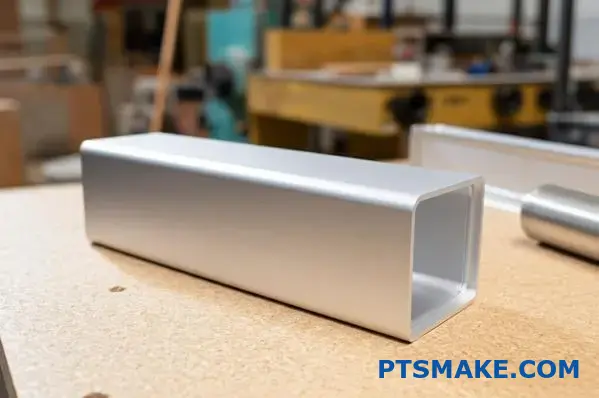
Acoustic Performance: The Sound of Metal
The primary goal of a speaker enclosure is to allow the driver to produce sound accurately without adding its own sonic signature. This is where aluminum’s rigidity truly shines.
By minimizing cabinet wall flex, an aluminum enclosure prevents the cabinet itself from becoming a secondary, unwanted sound source. This reduction in resonance leads to tighter bass, clearer midrange, and more precise audio imaging. In essence, you hear more of the speaker driver and less of the box.
However, metal surfaces can also lead to internal reflections if not managed properly. Good design incorporates internal bracing and acoustic damping1 materials to absorb or break up these reflections, ensuring the rigidity benefits aren’t compromised by internal acoustic issues. Based on projects we’ve collaborated on with clients, careful internal design is key when working with highly reflective materials like aluminum.
Comparing Aluminum to Traditional Materials
How does aluminum stack up against common choices like MDF (Medium-Density Fiberboard) and Plywood? Here’s a quick comparison based on typical characteristics:
| Feature | Aluminum | MDF (Medium-Density Fiberboard) | Plywood (Baltic Birch) |
|---|---|---|---|
| Rigidity | Very High | Moderate | High |
| Damping | Low (Requires added damping) | Good | Moderate |
| Cost | High | Low | Moderate |
| Weight | Moderate | Heavy | Moderate-Heavy |
| Machinability | Requires CNC/Special Tools | Easy (Standard Woodworking) | Moderate (Standard Woodworking) |
| Aesthetics | Premium, Versatile Finishes | Requires Veneer/Paint | Natural Wood Grain/Paint |

As the table shows, while MDF offers good damping and low cost, it lacks the rigidity of aluminum. Plywood, especially Baltic Birch, offers a good balance but still falls short of aluminum’s stiffness. Aluminum’s main trade-offs are its lower inherent damping (requiring design considerations) and higher cost.
Manufacturing Considerations: Precision Matters
Creating an aluminum speaker enclosure isn’t like building a wooden box. Its hardness and the need for precision demand specialized manufacturing processes.
- CNC Machining: This is the gold standard for producing high-quality aluminum enclosures. CNC (Computer Numerical Control) machining allows for incredibly precise cuts, complex shapes, tight tolerances, and repeatable results – all crucial for acoustic performance and perfect component fit. This aligns perfectly with the precision services we provide at PTSMAKE, where we handle complex geometries daily.
- Tolerances: Tight tolerances are essential for ensuring panels fit together perfectly, creating an airtight seal (vital for sealed or ported designs) and minimizing any potential rattles or buzzes.
- Cost: Machining aluminum is generally more time-consuming and requires more robust tooling than working with wood, which contributes to a higher manufacturing cost. Assembly might also involve machine screws rather than wood screws and glue.

Is Aluminum Always the Best Choice?
While aluminum offers significant advantages, it’s not automatically the best choice for every single speaker project.
- Cost-Sensitive Projects: For budget builds, MDF remains a very practical and acoustically sound option.
- Weight: If portability is paramount and extreme durability isn’t needed, lighter materials might be preferred, although aluminum offers a good strength-to-weight ratio.
- DIY Friendliness: Woodworking tools are more accessible and easier for hobbyists to use than metalworking or CNC equipment.
Aluminum truly excels in applications where:
- Ultimate acoustic transparency and minimal coloration are desired (high-end audio).
- A premium look and feel are part of the product identity.
- Durability and longevity are critical.
- Complex shapes or integrated features (like heat sinks) are needed.
Ultimately, the effectiveness of an aluminum speaker enclosure also heavily depends on the overall design – including driver selection, crossover design, internal bracing, and damping strategy. The material is just one part, albeit a very important one, of the equation.
Is Aluminum Speaker Enclosure Better Than Copper?
Thinking about high-end speaker materials? Does the gleam of copper tempt you, making you wonder if it outperforms the sleek look of aluminum for your enclosures?
Neither aluminum nor copper is definitively "better" for speaker enclosures; the optimal choice depends heavily on design priorities and budget. Aluminum excels in rigidity and low weight, minimizing cabinet resonance. Copper offers superior damping and thermal conductivity but is significantly heavier and more expensive.
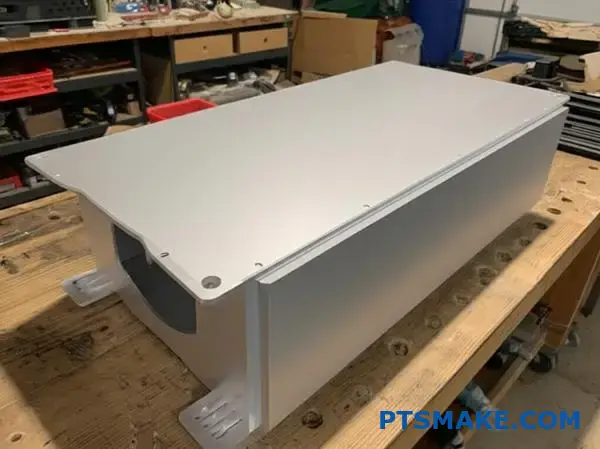
Choosing between aluminum and copper for a speaker enclosure isn’t just about looks; it’s a deep dive into material science and acoustics. Both metals offer a step up from traditional wood or MDF in certain aspects, but they bring different strengths and weaknesses to the table. In my experience at PTSMAKE, guiding clients through material selection for high-precision components, understanding these nuances is key to achieving the desired performance. Let’s compare aluminum and copper across the factors that matter most for speaker design.
Acoustic Performance: Rigidity vs. Damping
The way an enclosure material behaves under vibration is critical. Here, aluminum and copper present a fascinating trade-off.
- Aluminum: Its primary acoustic advantage is its high stiffness-to-weight ratio. Aluminum panels are very rigid, resisting flex and vibration caused by the speaker driver’s back pressure. This high rigidity helps prevent the enclosure itself from coloring the sound, leading to clearer audio reproduction with less unwanted cabinet resonance.
- Copper: While also rigid, copper is denser and possesses inherently better damping characteristics than aluminum. Damping refers to a material’s ability to dissipate vibrational energy as heat rather than transmitting it. This means copper can absorb vibrations more effectively, potentially reducing resonance without requiring as much added internal damping material compared to aluminum. However, its higher mass can sometimes be a factor in vibration modes.

So, aluminum fights resonance through sheer stiffness, while copper uses a combination of stiffness and better internal damping. The "better" approach often depends on the specific driver, enclosure size, and overall acoustic design philosophy.
Physical Properties: Weight, Cost, and Machinability
Beyond sound, practical considerations like weight, cost, and manufacturing complexity play huge roles.
- Weight: This is a major difference. Copper is nearly three times denser than aluminum. An enclosure made of copper will be significantly heavier than an identical one made of aluminum. This impacts portability, shipping costs, and the requirements for mounting or stands.
- Cost: Copper is typically much more expensive than aluminum, both as a raw material and often in terms of machining. Market fluctuations affect both, but copper consistently commands a higher price. This makes copper enclosures a distinctly premium or specialized option.
- Machinability: Both metals require robust CNC machining for precise results, something we handle routinely at PTSMAKE. However, they machine differently. Aluminum is generally considered easier and faster to machine accurately. Copper, while soft, can be ‘gummy’, requiring specific tooling, speeds, and feeds to achieve a good surface finish and avoid tool wear. Precision machining of copper can sometimes be more challenging and thus costlier.
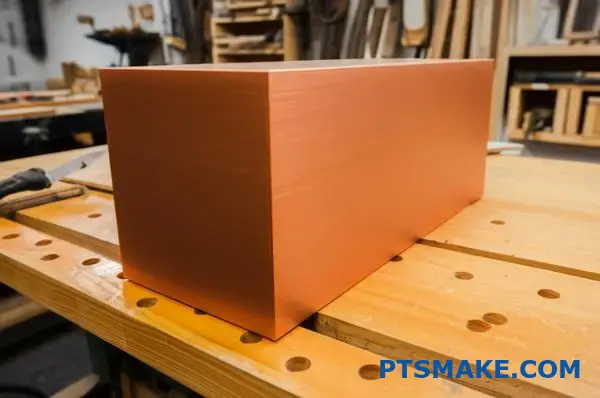
Thermal and Electrical Considerations
Metals conduct heat and electricity, which can be relevant in speaker design.
- Thermal Conductivity: Copper is one of the best thermal conductors, significantly better than aluminum. If the speaker enclosure needs to dissipate heat (e.g., from an internal amplifier in a powered speaker), copper offers superior performance, potentially acting as a more effective heat sink. Aluminum is still a good conductor, just not as effective as copper.
- Electrical Conductivity & Shielding: Copper is also a better electrical conductor than aluminum. This could theoretically offer slightly better electromagnetic interference (EMI) shielding for sensitive internal components. However, aluminum is also conductive and often provides sufficient shielding for most audio applications. The enclosure design (seams, openings) usually plays a bigger role in shielding effectiveness than the minor conductivity difference between the two metals.
Aesthetics and Corrosion Resistance
How the enclosure looks and lasts is also important.
- Aluminum: Offers a modern, clean look. It can be finished in many ways: anodizing (in various colors), brushing, polishing, powder coating. Aluminum naturally forms a tough, transparent oxide layer that protects it from corrosion.
- Copper: Has a distinct, warm reddish-gold color that is unique. It develops a patina (often greenish, known as verdigris) over time when exposed to the elements. This can be aesthetically desirable for some, creating a vintage or evolving look, but requires consideration if a consistent appearance is needed. Protective coatings can prevent patina formation.
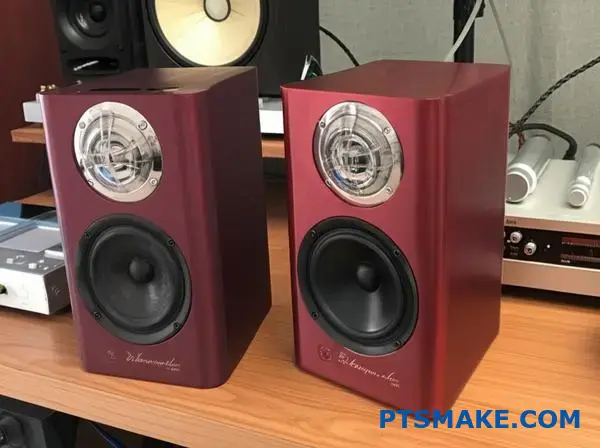
Comparison Summary
Let’s summarize the key differences in a table:
| Feature | Aluminum | Copper | Key Takeaway |
|---|---|---|---|
| Rigidity (Young’s Modulus2) | Good (Approx. 70 GPa) | Good (Approx. 117 GPa) | Copper is stiffer |
| Damping | Lower (Requires more design consideration) | Higher | Copper damps vibrations better |
| Density/Weight | Low (Approx. 2.7 g/cm³) | High (Approx. 8.96 g/cm³) | Aluminum is much lighter |
| Cost | Moderate-High | Very High | Copper is significantly pricier |
| Machinability | Generally easier | Can be ‘gummy’, requires specific techniques | Aluminum often easier for CNC |
| Thermal Conductivity | Good | Excellent | Copper is better for heat sink |
| Electrical Conduct. | Good | Excellent | Copper slightly better shield |
| Corrosion Resistance | Excellent (Natural oxide layer) | Good (Develops patina, may need coating) | Aluminum more stable appearance |
| Aesthetics | Modern, versatile finishes (anodizing) | Unique warm color, patina potential | Depends on desired look |
Making the Choice: Aluminum or Copper?
Based on our experience manufacturing precision parts for various industries, the choice usually boils down to these factors:
Choose Aluminum if:
- Low weight is important.
- You need high rigidity to control resonance without excessive weight.
- Budget is a significant constraint (compared to copper).
- You prefer modern aesthetics with options like colored anodizing.
- Manufacturing efficiency is a priority.
Choose Copper if:
- Maximum damping from the material itself is desired.
- Exceptional thermal conductivity is needed (e.g., high-power internal amps).
- Weight is not a concern or is even desirable for stability.
- Budget allows for a premium material and potentially more complex machining.
- The unique aesthetic of copper (or its patina) is specifically desired.
Neither material guarantees a better speaker; the entire system design is paramount. However, understanding the distinct properties of aluminum and copper allows designers and engineers to make informed decisions that align with their acoustic goals, budget, and product vision. At PTSMAKE, we’re equipped to machine both materials to the tight tolerances required for high-performance audio applications.
How Does the Type of Speaker Enclosure Change the Sound That Is Produced?
Ever notice how two speakers with similar drivers can sound completely different? Could the box itself be the hidden factor dramatically altering the bass punch and overall clarity you hear?
The type of speaker enclosure fundamentally changes the sound by managing the rearward sound waves from the driver. Designs like sealed, ported, or transmission lines distinctively shape bass depth, tightness, efficiency, transient response, and the speaker’s interaction with the listening room.
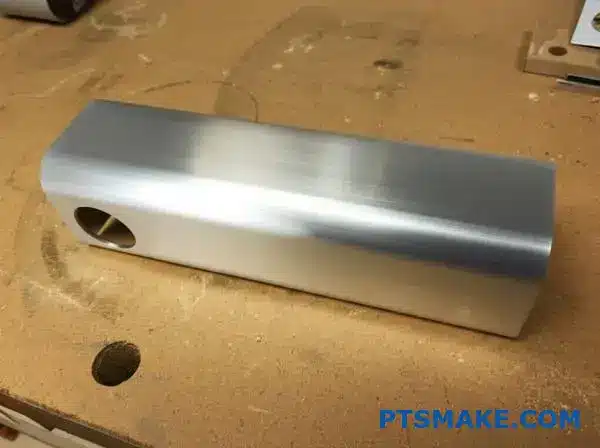
A speaker enclosure does far more than just house the driver; it’s an integral part of the acoustic system. The way it’s designed dictates how the energy produced by the back of the speaker cone is used—or suppressed. This management of rearward sound waves is the key difference between enclosure types and is critical to the final sound signature. Based on our experience at PTSMAKE crafting precision components for audio products, the enclosure design choice is as crucial as the driver selection itself.
The Crucial Role of the Enclosure
When a speaker driver cone moves forward, it creates sound waves you hear. When it moves backward, it creates identical sound waves inside the enclosure. If left unmanaged, these internal waves can interfere with the cone’s movement or escape the box out of phase, canceling out the desired sound, especially at low frequencies (bass). The primary job of any enclosure is to prevent this destructive interference. Different enclosure types achieve this in unique ways, leading to distinct sonic characteristics.
Common Enclosure Types and Their Sound Signatures
Let’s explore the most common designs and how they typically sound:
Sealed (Acoustic Suspension) Enclosures
Imagine a simple, airtight box. That’s a sealed enclosure. The air trapped inside acts like a spring, compressing as the cone moves inward and expanding as it moves outward.
- Sound: Known for tight, accurate, and well-defined bass. The sealed design offers excellent transient response3, meaning the speaker can start and stop quickly, reproducing percussive sounds cleanly. However, the bass usually doesn’t extend as deep as ported designs, and they tend to be less efficient, requiring more amplifier power.
- Manufacturing: Relatively simple to design and build, but achieving a perfect, long-lasting airtight seal requires precision. At PTSMAKE, ensuring precise fits and seals is routine in our CNC machining and molding processes.
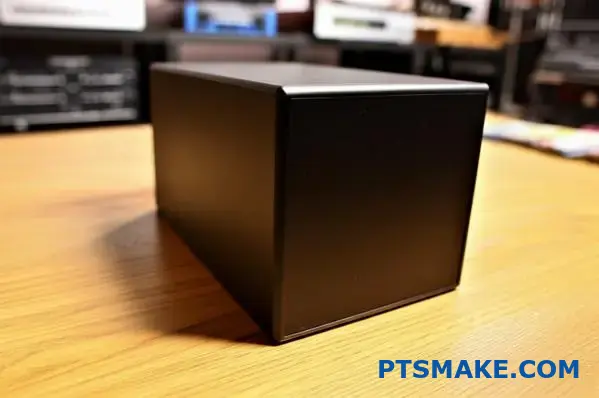
Ported (Bass Reflex) Enclosures
These enclosures feature a vent or port (a tube of specific length and diameter). This port is tuned to resonate at a particular frequency, using the driver’s rear wave energy to reinforce bass output.
- Sound: Generally produce deeper, more powerful bass than sealed enclosures of similar size. They are also more efficient. The trade-off can sometimes be slightly less tight or "slower" bass compared to sealed designs, and potentially audible port noise if poorly designed.
- Manufacturing: More complex than sealed designs. The port’s dimensions are critical and must be precise for accurate tuning. Incorrect port dimensions can ruin the intended sound profile. Achieving this precision, especially with materials like aluminum for an aluminum speaker enclosure, often involves CNC machining.
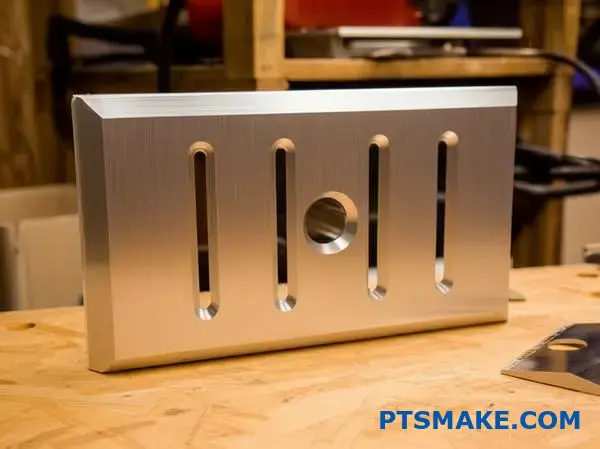
Transmission Line Enclosures
This design uses a long, folded path (the transmission line) inside the enclosure, lined with damping material. The goal is to absorb most of the driver’s rear wave energy or have it exit the line’s terminus in phase with the driver at very low frequencies.
- Sound: Can produce very deep, clean, and natural-sounding bass. Often considered a high-fidelity approach, but they are complex to design correctly.
- Manufacturing: Typically the most complex and largest common enclosure type. The internal path requires careful construction and precise dimensions. This complexity increases manufacturing costs significantly.
Passive Radiator Enclosures
Similar to ported designs, but instead of an open port, they use a passive radiator – essentially a speaker cone without a voice coil or magnet, driven by the air pressure inside the box created by the active driver.
- Sound: Offers bass extension similar to ported designs but avoids potential port noise issues. Can provide deep bass from relatively small enclosures. Tuning depends critically on the mass and compliance of the passive radiator.
- Manufacturing: Requires precise matching of the active driver, passive radiator, and enclosure volume. The passive radiator itself is an additional component cost.
How Enclosure Type Influences Key Sound Characteristics
Let’s compare how these designs impact specific audio qualities:
| Feature | Sealed (Acoustic Suspension) | Ported (Bass Reflex) | Transmission Line | Passive Radiator |
|---|---|---|---|---|
| Bass Depth | Moderate | Deep | Very Deep | Deep |
| Bass Tightness | Very Good | Good | Very Good | Good |
| Efficiency | Lower | Higher | Moderate to High | Higher |
| Size | Smallest | Moderate | Largest | Small to Moderate |
| Complexity | Low | Moderate | High | Moderate to High |
| Transient Response | Excellent | Good | Excellent | Good |

Choosing the Right Enclosure Type
The "best" enclosure type doesn’t exist in isolation; it depends entirely on the application and design goals:
- For Accuracy and Tight Bass: Sealed enclosures are often preferred, especially in studio monitors or audiophile systems where precision is paramount.
- For High Output and Deep Bass (Home Theater, PA): Ported or passive radiator designs often provide the desired impact and efficiency.
- For Ultimate Bass Extension (High-Fidelity): Transmission lines can offer exceptional performance but require significant space and budget.
- For Small Size with Good Bass: Passive radiators can be a great compromise.
The choice also interacts with the driver’s parameters (Thiele/Small parameters) and the intended use case. In past projects at PTSMAKE, we’ve seen how matching the enclosure type precisely to the driver and application through careful design and manufacturing leads to superior results, whether using traditional materials or advanced options like a precision-machined aluminum speaker enclosure for maximum rigidity in a ported system. The enclosure isn’t just a box; it’s a carefully tuned acoustic instrument.
What Are the Cost Benefits of Using Aluminum for Speaker Enclosures?
Is the higher upfront price tag of aluminum for speaker enclosures holding you back? Finding it hard to weigh that initial expense against potential long-term gains in performance and durability?
While aluminum speaker enclosures often have a higher initial cost compared to materials like MDF, their long-term cost benefits arise from exceptional durability reducing replacements, enhanced product value perception, and potential manufacturing efficiencies for complex or high-volume designs through processes like CNC machining.
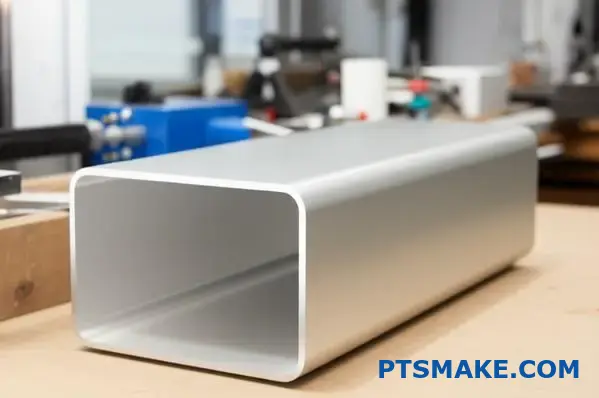
Aluminum often gets flagged for its cost when discussing speaker enclosure materials. It’s true that compared to MDF or standard plywood, the raw material price is higher. Additionally, working with metal typically requires more specialized manufacturing processes. However, looking only at the initial purchase price can be misleading. Over my time at PTSMAKE, helping clients optimize designs for manufacturing, I’ve learned that the true cost involves much more than just the material and initial fabrication. Let’s break down the cost factors associated with using aluminum for speaker enclosures to see where the real benefits lie.
Understanding the Initial Cost Drivers
It’s important to acknowledge why aluminum enclosures generally cost more upfront:
- Raw Material Cost: Aluminum alloys suitable for quality enclosures are inherently more expensive per unit volume or weight than MDF or most types of wood.
- Manufacturing Processes: Creating an aluminum enclosure, especially one with complex geometry or tight tolerances, usually requires CNC machining. While highly precise, CNC machining involves sophisticated equipment, programming, setup time, and specific tooling, which carries a higher cost than standard woodworking techniques used for MDF or plywood.
- Finishing: Achieving desired aesthetics like anodizing, powder coating, or brushing adds further processing steps and costs. While wood also requires finishing (painting, veneering), metal finishing processes can sometimes be more involved.
However, these upfront costs are only part of the story.
The Long-Term Value Proposition
This is where the cost benefits of an aluminum speaker enclosure start to emerge.
Durability and Longevity
Aluminum is exceptionally durable. It resists impacts, scratches, and environmental factors like humidity and temperature fluctuations far better than wood-based materials. An MDF enclosure might swell or weaken if exposed to moisture, while aluminum remains stable. This robustness translates directly into:
- Reduced Replacement Costs: An aluminum enclosure is likely to last much longer, reducing the need for replacement over the product’s lifespan.
- Lower Repair Costs: It’s less susceptible to damage that might require repairs. In demanding applications (e.g., professional audio, portable speakers), this durability is a significant cost saver.
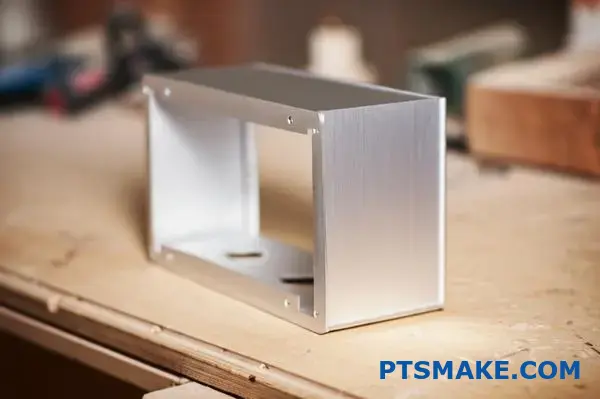
Lower Maintenance Needs
Wood enclosures might need refinishing over time, and damage can be harder to repair seamlessly. Aluminum, especially when anodized or powder-coated, requires minimal maintenance to keep its appearance and structural integrity. This saves on long-term upkeep expenses.
Enhanced Product Value and Brand Perception
Using premium materials like aluminum elevates the perceived value of the speaker. This allows for potentially higher pricing, improving return on investment. For brands positioning themselves in the high-fidelity or luxury markets, the premium feel and modern aesthetic of aluminum are essential and contribute directly to product desirability and brand image. This isn’t just about cost; it’s about value creation.
Manufacturing and Assembly Efficiencies
While initial fabrication might seem costly, aluminum offers advantages in manufacturing, especially at scale or for complex designs.
Precision and Consistency
CNC machining, the primary method for quality aluminum enclosures, delivers exceptional precision and repeatability. At PTSMAKE, achieving tolerances measured in micrometers is part of our daily work. This precision ensures:
- Easier Assembly: Parts fit together perfectly, reducing assembly time and labor costs.
- Reduced Rework and Waste: High consistency minimizes the chances of defective parts, saving material and reprocessing costs. An airtight seal, critical for acoustic performance, is more reliably achieved.
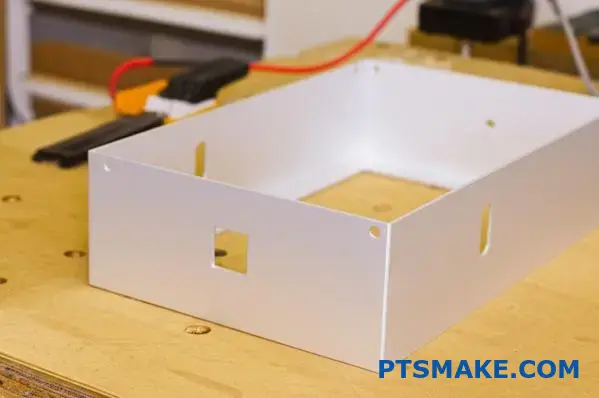
Integration Opportunities
Aluminum’s strength and machinability allow for integrating features directly into the enclosure structure. For example:
- Built-in Heat Sinks: For powered speakers, the enclosure itself can be designed to dissipate heat, eliminating the need for separate heat sink components and associated assembly steps.
- Integrated Mounting Points: Threaded holes or mounting bosses can be machined directly into the enclosure, simplifying assembly and potentially reducing the overall part count.
Scalability
While the setup cost for CNC machining might be higher than basic woodworking tools, the process is highly automated. For larger production volumes, the per-unit cost of a CNC-machined aluminum speaker enclosure can become competitive, especially if the design complexity would require significant manual labor with wood.
Comparing Total Cost of Ownership (TCO)
To truly assess the cost benefits, we need to look beyond the initial price tag and consider the Total Cost of Ownership4. This includes the initial cost plus all expenses incurred during the product’s life, factoring in durability, maintenance, and potential value enhancement.
Here’s a simplified comparison:
| Factor | Aluminum Speaker Enclosure | MDF/Wood Speaker Enclosure |
|---|---|---|
| Initial Cost | Higher | Lower |
| Durability/Lifespan | Very High | Moderate to Low |
| Maintenance Needs | Very Low | Moderate (potential repairs) |
| Resistance to Environment | High | Low (esp. humidity) |
| Perceived Product Value | High | Moderate to Low |
| Potential for Integration | High | Low |
| Manufacturing Precision | Very High | Moderate |
| Long-Term Cost (TCO) | Potentially Lower | Potentially Higher |
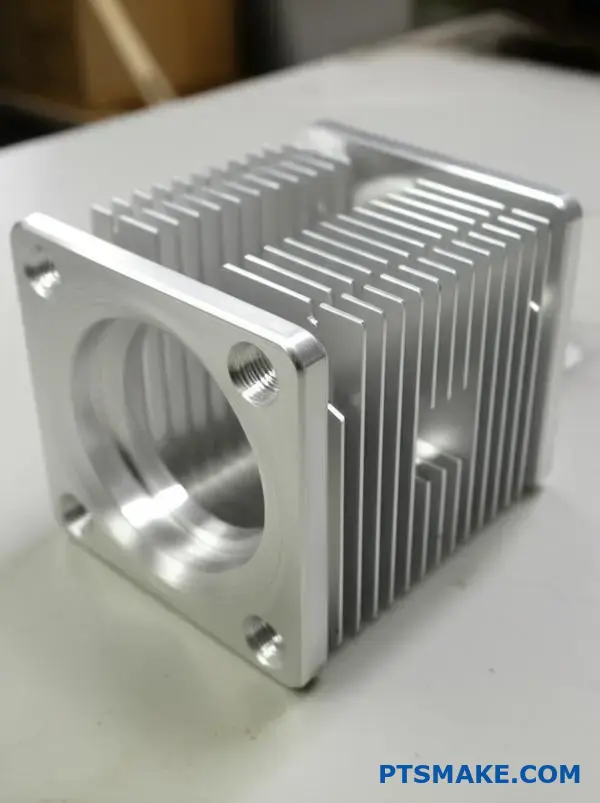
When Does Aluminum Make Financial Sense?
Based on project experiences at PTSMAKE, the higher initial cost of aluminum is often justified when:
- Longevity and durability are paramount: For products expected to last many years or operate in challenging environments.
- Premium performance and aesthetics are required: High-end audio markets where buyers expect top-tier materials and build quality.
- Design complexity or integration is needed: When features like heat sinks or precise mounting are part of the design.
- Weight needs to be managed alongside rigidity: Aluminum offers a better stiffness-to-weight ratio than steel and is more durable than most plastics or woods.
- Total Cost of Ownership is prioritized: When looking at the entire product lifecycle, including potential replacement and maintenance costs.
So, while the sticker price of an aluminum speaker enclosure might seem high, its long-term durability, low maintenance, manufacturing precision, and contribution to product value often result in significant cost benefits over the lifetime of the product. It’s an investment that pays off in quality, longevity, and user satisfaction.
How Does Aluminum Speaker Enclosure Design Impact Acoustic Performance?
Ever selected aluminum for its rigidity, only to find the final sound wasn’t quite what you expected? Could subtle design choices in your aluminum enclosure be undermining its acoustic potential?
The design of an aluminum speaker enclosure critically impacts acoustic performance by dictating internal volume accuracy, controlling resonances through shape and bracing, managing internal reflections via damping, and ensuring structural integrity with precise manufacturing tolerances. These factors determine bass response, clarity, and overall sound fidelity.
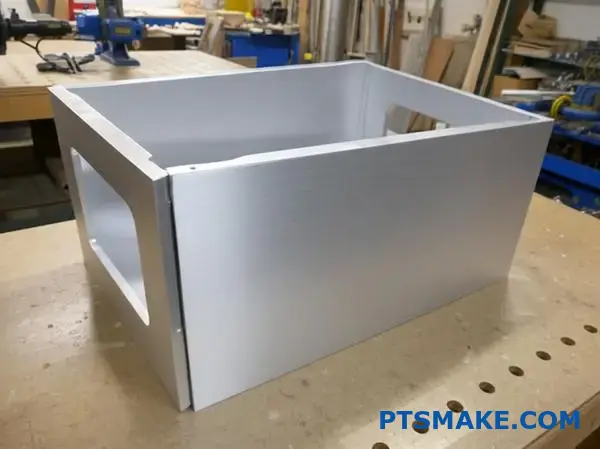
Choosing aluminum for a speaker enclosure is often driven by its excellent stiffness-to-weight ratio, aiming for a rigid, non-resonant cabinet. However, the material itself is just the starting point. Realizing aluminum’s full acoustic potential hinges entirely on thoughtful design and precise execution. In past projects, we’ve seen how identical aluminum material can yield vastly different sonic results based purely on the enclosure’s design details. It’s the careful consideration of volume, shape, internal structure, and manufacturing precision that truly unlocks superior sound. Let’s delve into how specific design elements of an aluminum speaker enclosure shape its acoustic output.
The Role of Enclosure Volume and Shape
The internal volume of any speaker enclosure is fundamental, directly influencing the bass response, especially in sealed and ported designs. Aluminum allows for very precise internal volumes due to the stability and machinability of the material. CNC machining, a core service at PTSMAKE, enables us to achieve exact target volumes consistently, which is critical for predictable low-frequency performance.
Shape also plays a significant role. Simple rectangular boxes can suffer from internal standing waves, where sound waves reflect between parallel surfaces, causing peaks and dips in the frequency response.
- Non-Parallel Walls: Designing enclosures with slightly angled or non-parallel walls helps break up these standing waves, leading to smoother midrange and bass response.
- Curved Surfaces: Gently curved surfaces can further reduce internal reflections and also minimize external diffraction5 – the bending of sound waves around sharp edges, which can blur sonic imaging. Aluminum lends itself well to machining complex curves that are harder to achieve reliably with wood.
Internal Bracing and Its Importance
While aluminum is very rigid, large, flat panels can still resonate at certain frequencies, especially under pressure from powerful drivers. Internal bracing acts like the skeleton of the enclosure, dramatically increasing panel stiffness.
- Function: Braces connect opposing panels or reinforce large surface areas, effectively shortening the unsupported spans and pushing resonant frequencies much higher, often outside the critical audio band or making them less energetic.
- Types: Common methods include window bracing (large cutouts), matrix bracing (a grid structure), or strategically placed ribs.
- Precision: For bracing to be effective, it must make solid contact with the panels it supports. CNC machining ensures braces are cut precisely and fit tightly, maximizing their stiffening effect – a level of precision we prioritize in our manufacturing processes.

Damping Strategies for Aluminum Enclosures
Aluminum has very low internal damping compared to materials like MDF. This means that once it starts vibrating, it doesn’t stop quickly – it tends to ‘ring’. While rigidity helps prevent vibration in the first place, some energy transfer is inevitable. Therefore, incorporating damping materials is crucial in aluminum speaker enclosure design.
- Purpose: Damping materials (like constrained layer damping sheets, bitumen pads, or specialized acoustic foam) absorb vibrational energy, converting it into tiny amounts of heat. This quickly stops panels from ringing and also helps absorb internal acoustic reflections.
- Application: Damping is typically applied directly to the inner surfaces of the enclosure panels, particularly large, flat areas away from bracing. The type and amount of damping need careful consideration to control resonance without overly deadening the sound or taking up too much critical internal volume.
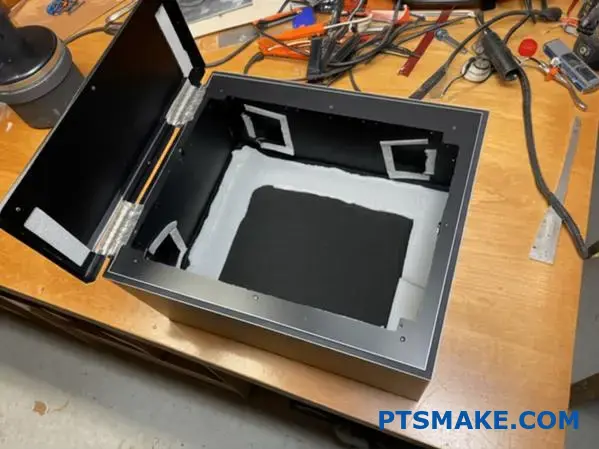
The Criticality of Manufacturing Tolerances
Precision manufacturing is non-negotiable for high-performance speaker enclosures, especially when using aluminum. Tight tolerances impact acoustics in several ways:
- Air Leaks: In sealed and ported designs, unintended air leaks can drastically alter the tuning, reduce bass output, and potentially cause whistling noises. Precise machining ensures panels join perfectly, maintaining the intended acoustic alignment.
- Panel Fitment: Poorly fitting panels or components can rattle or buzz when subjected to vibration, introducing unwanted noise.
- Driver Mounting: A perfectly flat and secure mounting surface for the driver ensures an airtight seal, preventing rear wave leakage that can degrade performance.
Achieving the tight tolerances required for acoustically inert enclosures is a hallmark of quality CNC machining.
| Feature | Loose Tolerances Effect | Tight Tolerances Benefit |
|---|---|---|
| Panel Joints | Potential air leaks, altered tuning, rattles | Airtight seals, maintained tuning, no joint noise |
| Driver Seal | Air leaks, bass loss, potential driver vibration | Optimal driver performance, prevents rear wave leakage |
| Bracing Fit | Reduced effectiveness, potential brace rattles | Maximum stiffening, solid energy transfer |
| Overall | Unpredictable performance, unwanted noise | Predictable acoustics, structural integrity |
Wall Thickness and Material Distribution
Choosing the right wall thickness is a balancing act. While thicker aluminum generally means greater rigidity, it also increases weight and cost. There are diminishing returns; beyond a certain point, adding thickness provides little acoustic benefit but significantly adds expense.
- Strategic Variation: Advanced designs might use variable wall thicknesses. For instance, the front baffle (where the driver mounts) might be made thicker to provide maximum support and minimize vibration, while side walls could be slightly thinner, relying more on bracing.
- FEA (Finite Element Analysis): Computer modeling like FEA can help optimize material distribution, identifying areas needing reinforcement and allowing designers to use material efficiently without over-engineering.
- CNC Machining: This process easily facilitates designs with varying thicknesses or complex internal structures optimized through analysis.

In essence, the design details – from the overall shape down to the precision of each joint – work synergistically with aluminum’s inherent properties. A well-designed aluminum speaker enclosure, manufactured with high precision like we strive for at PTSMAKE, minimizes unwanted resonances and distortions, allowing the speaker driver to perform at its absolute best and deliver clear, accurate sound. It confirms that material choice is only half the battle; design execution is the other, equally important half.
Can Aluminum Speaker Enclosures Be Customized for High-Volume Production?
Dreaming of unique aluminum speaker enclosures but worried about scaling up production? Does the complexity of customization seem too daunting when you need thousands of units?
Yes, aluminum speaker enclosures can definitely be customized for high-volume production. Success relies heavily on choosing the right manufacturing processes, like CNC machining or die casting, and applying Design for Manufacturability (DFM) principles early in the design stage.

Moving from a custom prototype or low-volume run to high-volume production presents unique challenges, especially with a material like aluminum that demands precision. At PTSMAKE, we frequently guide clients through this transition, ensuring their unique design vision can be realized efficiently and cost-effectively at scale. The key isn’t if it can be done, but how it’s approached. Let’s explore the factors that make custom, high-volume aluminum enclosures feasible.
Key Customization Areas Amenable to Scale
Even in high volume, several aspects of an aluminum speaker enclosure can be tailored:
Size and Shape
While extremely complex, one-off shapes might be challenging for the highest volumes, modern manufacturing allows for considerable geometric freedom. CNC machining offers great flexibility for intricate shapes even in volume, while die casting excels at producing consistent complex shapes once the initial tooling is created. Non-standard dimensions, unique profiles, and specific internal structures are all achievable.
Finishes and Aesthetics
Aluminum offers a wide range of finishing options that are well-suited for mass production:
- Anodizing: Creates a durable, corrosion-resistant surface available in various colors. It’s a batch process suitable for large quantities.
- Powder Coating: Provides a tough, decorative finish in nearly any color. Efficient application lines make it cost-effective for volume.
- Brushing/Polishing: Achieves specific surface textures. Automated processes can handle these finishes consistently on large batches.
- Laser Engraving: Logos, serial numbers, or other markings can be added rapidly and consistently using automated laser systems.
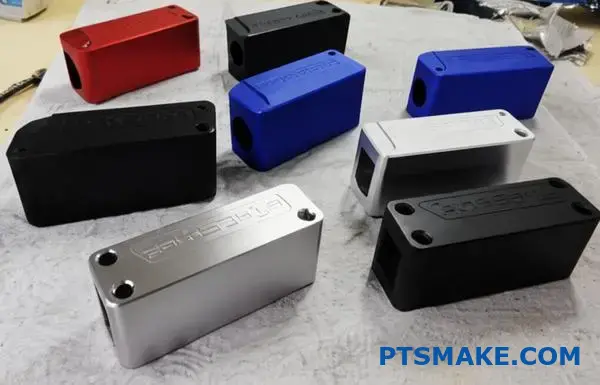
Mounting Options and Integration
Custom mounting points, specific hole patterns for drivers or internal components, and integrated features like heat sinks or cable management channels can be incorporated into the design and mass-produced accurately, particularly with CNC machining or well-designed die casting molds.
Manufacturing Methods for High-Volume Customization
The choice of manufacturing process is critical for balancing customization, cost, and volume.
CNC Machining
Computer Numerical Control (CNC) machining involves cutting enclosures from solid blocks or extrusions of aluminum.
- Pros: High flexibility for design changes, excellent precision and tight tolerancing6, suitable for complex geometries, no high initial tooling cost like die casting. Ideal for moderate to high volumes where design evolution might occur.
- Cons: Can have a higher per-unit cost compared to die casting at very large volumes due to cycle times.
- PTSMAKE Fit: Our expertise lies in high-precision CNC machining, capable of handling both prototype runs and scaling up to significant production volumes while maintaining consistency.
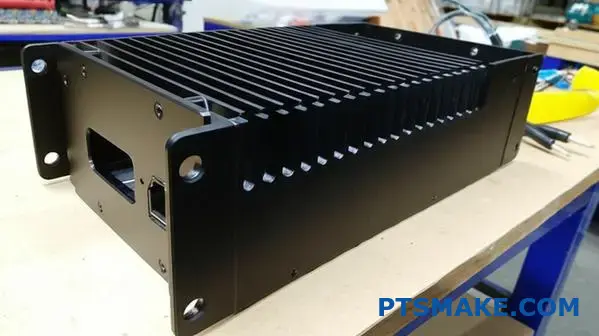
Die Casting
This process involves injecting molten aluminum into a custom steel mold (die) under high pressure.
- Pros: Very low per-unit cost at extremely high volumes (tens of thousands or more), fast cycle times once set up, excellent for complex shapes repeatable identically.
- Cons: Very high initial tooling investment, design changes are expensive and time-consuming, less flexibility than CNC, potentially lower precision in some features compared to machining.
- Best For: Stable designs needed in very large quantities where upfront tooling cost can be amortized.
Hybrid Approaches
Sometimes, a combination works best. For example, a main body might be die-cast for cost efficiency, while specific features requiring higher precision are added via secondary CNC machining operations.
Here’s a comparison relevant to high-volume customization:
| Feature | CNC Machining | Die Casting |
|---|---|---|
| Initial Cost | Low (No hard tooling) | Very High (Mold creation) |
| Per-Unit Cost (High Vol.) | Moderate to High | Very Low |
| Design Flexibility | High (Easy program changes) | Low (Mold modification is costly/difficult) |
| Complexity | Handles very complex shapes well | Excellent for repeatable complex shapes |
| Precision | Very High | Good, but potentially limited by draft angles etc. |
| Lead Time (Initial) | Shorter | Longer (Due to mold making) |
| Lead Time (Production) | Longer cycle time per part | Very fast cycle time per part |
| Best Volume | Prototype to High Volume (Hundreds to thousands) | Very High Volume (Tens of thousands+) |
Design for Manufacturability (DFM)
This is perhaps the most crucial element for scaling custom aluminum enclosures. Applying DFM principles early involves designing the part with the chosen manufacturing process in mind to optimize for efficiency, cost, and quality. Working with a manufacturing partner like PTSMAKE during the design phase allows us to:
- Simplify complex features where possible without compromising function.
- Optimize wall thicknesses for material usage and process capability.
- Design features suitable for efficient machining paths or die casting ejection.
- Ensure tolerances are specified appropriately – tight where needed, relaxed where not critical, to manage costs.
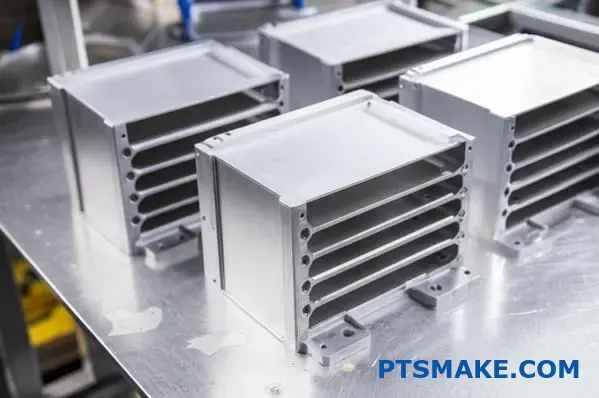
Partnering for Success
Successfully customizing aluminum speaker enclosures for high-volume production requires collaboration. A good manufacturing partner brings expertise not just in making parts, but in advising on material selection, process optimization, and DFM. At PTSMAKE, we leverage our 15+ years of experience in precision manufacturing to help clients navigate the path from concept to mass production smoothly, ensuring their custom aluminum speaker enclosure meets both performance specifications and volume requirements effectively. The ability to customize at scale is achievable with the right strategy and partner.
What Are the Thermal Management Advantages of Aluminum Speaker Enclosures?
Ever worried about your powered speakers running too hot during long listening sessions? Concerned that built-up heat could degrade audio performance or even shorten the lifespan of internal electronics?
The primary thermal advantage of aluminum speaker enclosures lies in their excellent thermal conductivity. This property allows the metal casing to act effectively as a heat sink, drawing heat away from internal components like amplifiers and power supplies, improving reliability and performance.

Heat is an unavoidable byproduct of electronic components, especially amplifiers and power supplies commonly found in active speakers. If this heat isn’t managed effectively, it can lead to problems. Components operating above their ideal temperature range can suffer from reduced lifespan, inconsistent performance, and even outright failure. This is where the choice of enclosure material becomes crucial, not just for acoustics, but for thermal stability too.
Why Thermal Management Matters in Speakers
Modern speakers, particularly active models with built-in amplification, generate significant heat. Key sources include:
- Amplifier Circuits: Power transistors and other components in the amplifier module dissipate energy as heat.
- Power Supplies: Converting AC power to DC power for the electronics generates heat.
- Speaker Drivers: While less significant than amplifiers, the voice coil itself heats up during operation, which can subtly affect performance over time (power compression).
Ineffective heat dissipation can lead to:
- Thermal Throttling: Amplifiers might reduce their output power automatically to prevent overheating.
- Component Degradation: Prolonged high temperatures shorten the lifespan of electronic components like capacitors.
- Performance Drift: Temperature changes can slightly alter the parameters of speaker drivers and crossover components.
An enclosure material that aids heat removal helps mitigate these issues.
Aluminum’s Superior Heat Dissipation Capability
Aluminum stands out among common enclosure materials for its thermal properties. Its key advantage is high thermal conductivity7. This means heat energy travels easily through aluminum.
Let’s compare it qualitatively to other materials:
| Material | Relative Thermal Conductivity | Primary Thermal Role in Enclosure |
|---|---|---|
| Aluminum | High | Conducts heat away effectively |
| Steel | Moderate | Conducts heat, but less effectively |
| MDF / Wood | Very Low | Acts as an insulator (traps heat) |
| Plastics (Typical) | Very Low | Acts as an insulator (traps heat) |
As the table shows, wood and plastic tend to trap heat inside the enclosure, making them poor choices for thermal management without significant ventilation. Steel is better, but aluminum is generally superior for passively conducting heat.
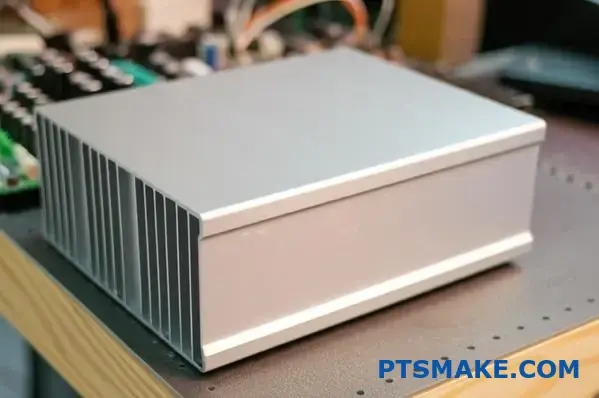
How an Aluminum Enclosure Acts as a Heat Sink
An aluminum speaker enclosure leverages its conductivity to function as a large passive heat sink. The process works like this:
- Conduction: Heat generated by internal components (like an amplifier module bolted to the inside wall) flows directly into the aluminum enclosure material.
- Spreading: Aluminum’s high conductivity allows this heat to spread quickly across the entire surface area of the enclosure, preventing localized hot spots.
- Dissipation: The heat is then transferred from the outer surface of the aluminum enclosure to the surrounding air through two main mechanisms:
- Convection: Air in contact with the warm surface heats up, becomes less dense, and rises, carrying heat away. Cooler air replaces it, continuing the cycle.
- Radiation: The warm surface emits thermal energy as infrared radiation directly into the environment.
The large surface area of the entire enclosure becomes available for dissipating heat, which is often far more effective than relying solely on small, dedicated heat sinks inside a thermally insulating box.
Tangible Benefits of Aluminum’s Thermal Performance
Using aluminum for speaker enclosures translates into real-world advantages:
Improved Reliability and Longevity
By keeping internal components cooler, aluminum enclosures help prevent overheating damage. This directly contributes to a longer operational lifespan for amplifiers, power supplies, and other sensitive electronics within the speaker. Based on client collaborations at PTSMAKE, products designed with thermal management in mind often see lower failure rates.
Sustained Audio Performance
Heat can negatively impact performance. Amplifiers might suffer from increased distortion or reduced power output (thermal compression) when hot. Keeping temperatures stable helps ensure consistent audio quality, even during extended use at high volumes.
Potential for More Compact and Integrated Designs
Because the enclosure itself aids significantly in cooling, designers might be able to:
- Reduce the size or number of dedicated internal heat sinks.
- Integrate amplification more tightly within the speaker cabinet without risking overheating.
- Design sleeker, less ventilated enclosures for certain power levels, relying on the aluminum’s passive dissipation.

Design Considerations for Optimal Cooling
Simply using aluminum isn’t a guarantee of perfect thermal management. Smart design choices enhance its effectiveness:
Integrated Heat Sink Features
With processes like CNC machining, which we specialize in at PTSMAKE, external heat sink fins can be machined directly into the aluminum enclosure body. This significantly increases the surface area available for convection and radiation, dramatically boosting cooling capacity without adding separate parts.
Strategic Component Placement
Mounting heat-generating components (like amplifier modules) directly to a large internal surface of the aluminum enclosure ensures efficient thermal transfer via conduction.
Surface Finish
The emissivity of the surface finish affects radiative cooling. Generally, matte or dark finishes (like black anodizing or powder coating) radiate heat slightly more effectively than highly polished or bare aluminum surfaces.
Wall Thickness
While primarily chosen for rigidity, wall thickness also influences thermal spreading. Thicker aluminum can help distribute heat more evenly across the enclosure surface, although excessive thickness adds unnecessary weight and cost.
Ventilation (If Necessary)
For very high-power applications, even an aluminum enclosure might benefit from some ventilation to enhance convective airflow. However, aluminum’s conductivity means ventilation requirements might be less stringent compared to wood or plastic enclosures.
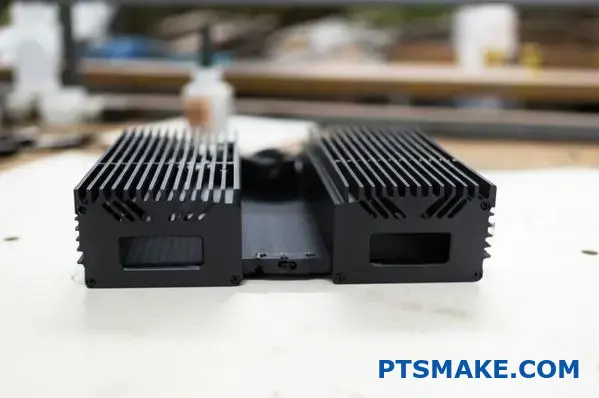
In summary, the excellent thermal conductivity of an aluminum speaker enclosure is a major advantage, particularly for powered speakers. It allows the enclosure to double as an effective heat sink, pulling damaging heat away from sensitive electronics. This contributes to improved reliability, sustained performance, and opens up possibilities for more integrated and compact designs – benefits we’ve seen realized in numerous projects involving precision-manufactured aluminum components.
How Durable Are Aluminum Speaker Enclosures Compared to Plastic or Wood?
Ever worried about your speakers getting damaged easily? Wondering if that plastic or wood enclosure can really handle daily use or accidental bumps?
Aluminum speaker enclosures are significantly more durable than typical plastic or wood options. Their metal construction offers superior resistance to impacts, scratches, environmental factors like humidity, and general wear and tear, ensuring a much longer lifespan.
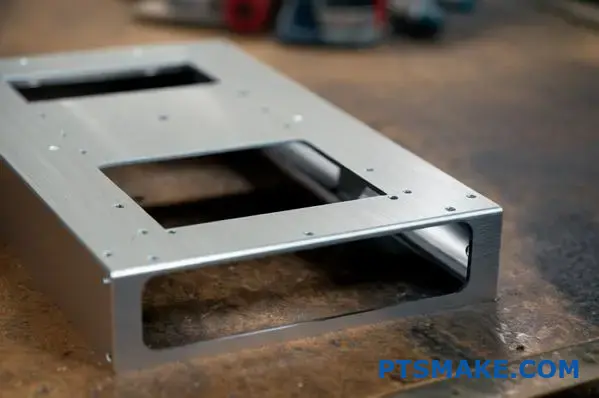
When choosing a speaker, sound quality is often the top priority. But durability is just as important, especially if the speaker will be moved often or used for many years. An enclosure needs to protect the sensitive components inside and maintain its structural integrity. Based on our manufacturing experience at PTSMAKE, working with various materials for demanding applications, aluminum consistently stands out for its toughness compared to common plastic and wood choices. Let’s look at why.
Defining Durability in Speaker Enclosures
What do we mean by durability in this context? It covers several aspects:
- Impact Resistance: How well the enclosure withstands accidental drops, bumps, or knocks.
- Scratch and Wear Resistance: How well the surface holds up against scratches, scuffs, and general handling over time.
- Environmental Stability: How the material reacts to changes in humidity, temperature, and UV exposure.
- Structural Integrity: The enclosure’s ability to maintain its shape and rigidity over its lifespan without warping, cracking, or joints loosening.
Aluminum’s Durability Advantages
Aluminum alloys commonly used for enclosures possess inherent properties that make them very durable.
Impact Resistance
Aluminum is a strong metal. Compared to most plastics used in speakers, it can take much harder hits without cracking or shattering. While wood, especially solid wood or quality plywood, can be quite strong, it tends to dent or splinter upon sharp impact. Corners on MDF enclosures are particularly vulnerable to chipping. Aluminum generally just dents under severe impact, often remaining structurally sound. We see this resilience frequently in the precision aluminum parts we machine at PTSMAKE for various industries.
Scratch and Wear Resistance
The surface hardness of aluminum provides good resistance to everyday scratches and scuffs. This can be significantly enhanced with surface treatments. Anodizing, for example, creates an extremely hard, ceramic-like layer integrated with the metal. Powder coating adds a tough, paint-like layer. Plastics, especially softer ones like ABS, tend to scratch easily, showing wear quickly. Wood finishes can also wear down or scratch off over time, exposing the more vulnerable material underneath.
Environmental Stability
This is a major advantage for aluminum. It does not absorb moisture, so it won’t swell, warp, or lose integrity in humid environments like wood can. Wood, including MDF and plywood, is notoriously susceptible to humidity changes, which can affect dimensions, joint strength, and even acoustic properties. Plastics can become brittle over time with UV exposure or extreme temperature cycles. Aluminum remains stable across a wide range of temperatures and is inherently resistant to corrosion thanks to its natural oxide layer, further enhanced by finishes like anodizing.
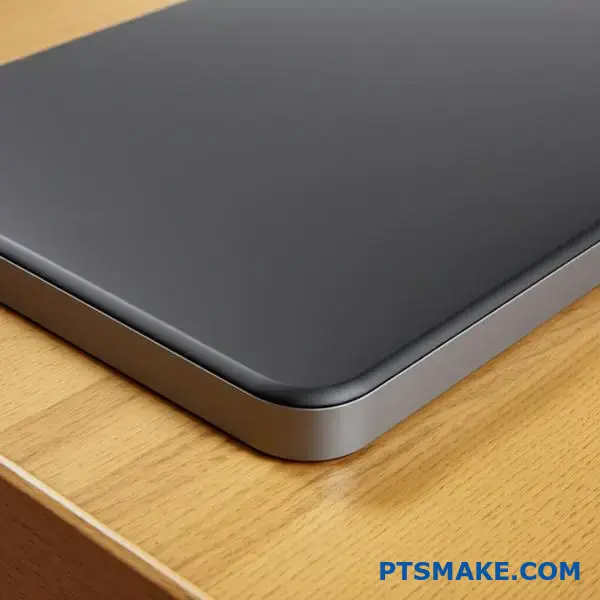
Structural Integrity and Longevity
An aluminum speaker enclosure maintains its shape and rigidity exceptionally well over decades. Metal construction, especially when precisely assembled using methods like CNC machining for tight tolerances, ensures strong, lasting joints. Wood joints can weaken over time due to wood movement or glue degradation. Plastic enclosures can suffer from material creep or Fatigue8, potentially leading to cracks or loss of rigidity, especially under constant load or vibration.
Comparing with Plastic Enclosures
Plastic enclosures are common, especially in lower-cost or portable speakers.
Types of Plastics
Materials like ABS (Acrylonitrile Butadiene Styrene) or Polycarbonate (PC) are often used. ABS is affordable and reasonably tough, while PC is stronger but more expensive. High-performance engineered plastics exist but push costs closer to aluminum.
Weaknesses
Standard plastics are generally less rigid than aluminum, which can impact acoustic performance (more cabinet resonance). They are more prone to scratching and can become brittle or discolor with age and UV exposure. While impact resistance varies, cheaper plastics can crack easily. Their lower density is an advantage for weight, but often comes at the cost of robustness and acoustic inertness compared to a well-designed aluminum speaker enclosure.
Comparing with Wood Enclosures
Wood has a long history in speaker building, favored for its workability and acoustic properties (damping).
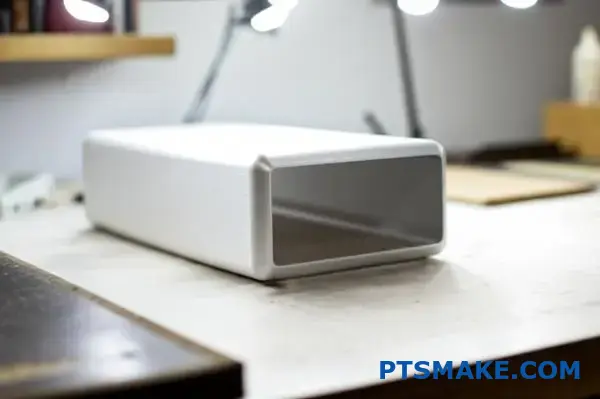
Types of Wood
MDF (Medium-Density Fiberboard) is very common due to its density and low cost. Plywood (especially Baltic Birch) offers better strength and moisture resistance than MDF. Solid hardwood is less common due to cost and stability issues (warping/cracking).
Weaknesses
The primary weakness of all wood-based materials is sensitivity to moisture and humidity. Swelling, warping, and joint failure are real risks in non-stable environments. They are also generally softer than aluminum, making them more susceptible to dents, deep scratches, and corner damage. While acoustically good, their physical durability is lower.
Putting it Together: A Comparative Overview
This table summarizes the general durability characteristics:
| Feature | Aluminum | Plastic (ABS/PC Typical) | Wood (MDF/Plywood Typical) |
|---|---|---|---|
| Impact Resistance | High | Medium | Medium to Low |
| Scratch Resistance | High (Very High w/Finish) | Low to Medium | Low |
| Env. Stability | Very High | Medium (UV/Temp limits) | Low (Humidity sensitive) |
| Longevity | Very High | Medium | Medium to Low |
When Does Durability Matter Most?
The superior durability of aluminum is particularly valuable in specific situations:
- Portable Speakers: Constant handling and transport demand resistance to bumps and scratches.
- Professional Audio: Equipment used for gigs (PA systems, stage monitors) faces rough handling and varied environments.
- Outdoor or Marine Use: Resistance to moisture and temperature fluctuations is essential.
- Long-Term Investment: For high-end speakers intended to last for decades, aluminum provides peace of mind.
- Public Spaces: Speakers installed in commercial or public areas benefit from enhanced toughness against wear and potential vandalism.
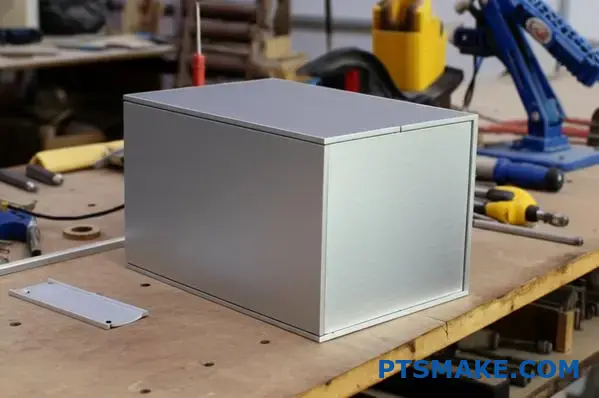
Of course, this durability comes at a higher initial cost and weight compared to most plastics and MDF. However, aluminum’s excellent strength-to-weight ratio means enclosures can often be designed to be strong without being excessively heavy. For applications where reliability and longevity are paramount, the investment in an aluminum speaker enclosure often pays off. At PTSMAKE, producing robust and precisely manufactured aluminum components is a core part of our business, ensuring products meet the demanding durability needs of our clients.
Click to understand how damping materials absorb unwanted sound energy within speaker enclosures, improving clarity. ↩
Learn more about Young’s Modulus and understand how this measure of stiffness influences material selection for optimal acoustic performance in enclosures. ↩
Understand transient response: how quickly a speaker reacts to signal changes, affecting sound clarity and punch. ↩
Learn about Total Cost of Ownership to fully evaluate the lifetime expenses beyond the initial purchase price. ↩
Explore how edge diffraction affects sound waves and speaker clarity. ↩
Tolerancing defines permissible limits of variation in dimensions for manufacturing precision and part functionality. ↩
Click to understand thermal conductivity: how well materials transfer heat, crucial for cooling electronics. ↩
Click to understand how material fatigue leads to failure under repeated stress. ↩


